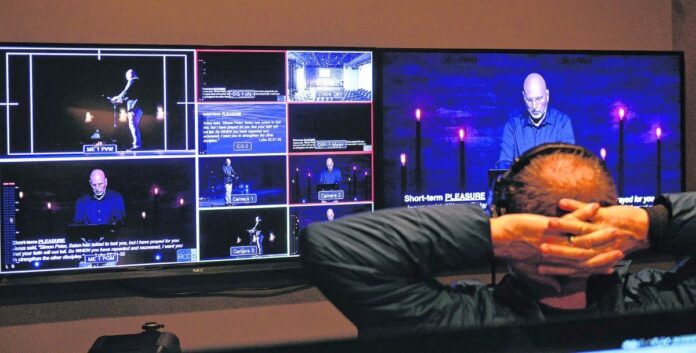
It’s a making-do scenario: To film without a camera, the church used an older-model smartphone. To position that lens at the right height, those filming mounted the phone on the wall with duct tape.
Tim Shapiro says it’s a true story he heard from an Indiana congregation. But the story didn’t end there for that church and others like it, thanks to technology grants from the Lilly Endowment-funded Center for Congregations. Shapiro is president of the center.
Now many congregations in Hancock County and other communities are buying or upgrading cameras, computers and other equipment to enhance their ability to offer services and other spiritual content online.
When many churches stopped gathering for in-person services during the coronavirus quarantine in the spring, they shifted to presenting sermons and/or music for worshipers to view from their homes.
[sc:text-divider text-divider-title=”Story continues below gallery” ]
As a result, many houses of worship were scrambling to bolster — or in some cases establish — their online presence.
“We went to, basically overnight, all online,” said the Rev. Janna Meyers, pastor of St. John United Church of Christ south of Cumberland. “We’ve continued all of church life online.”
The church had services online in the spring, resumed in-person worship with distancing in July, and recently resumed online-only worship for now.
In the spring, early efforts in sharing services online began with a phone, but the church bought and mounted a camera and later added a handheld camera.
Meyers said upgrading technology has helped the church prerecord solos for services so no one was singing in front of a live congregation; the coronavirus is thought to spread through droplets projected when people talk, cough or sing.
Upgrades also help the church record a service on DVD, to share with members who cannot connect online.
Much of what the Center for Congregations funds through grants focuses on leadership development or strategic planning. It offers an online resource guide and workshops (centerforcongregations.org). In a typical year, its grants often fund facility studies, for example, and not necessarily equipment.
But when churches were shifting online, the Rev. Clarence Moore, senior pastor of New Era Church in Indianapolis, reached out to the center and inspired it to launch the Connect Through Tech grants.
“I know they’ve had a huge response,” said the Rev. Anthony Stone of New Palestine United Methodist Church. He said there are a lot of pieces to the presentation of a service online, from having the bandwidth capacity for streaming the service live to having camera switchers that can remotely change which camera’s view is being shown at that moment.
Greenfield Christian Church (Disciples of Christ) bought equipment to stream services live instead of recording them to post.
“We felt we needed to reach out to our congregation with a live service on Sundays to come as close as we could to providing a sense of Sunday worship service remotely,” Doug Moore, chairman of the church’s technology committee, wrote in an email to the Daily Reporter.
The aim was similar at Park Chapel Christian Church.
“Park Chapel purchased the necessary switches and recording equipment to edit our online service in-house, in real time,” wrote Cheri Cole, the church’s director of ministry logistics, in an email to the Daily Reporter. “The ability to do this means we can transmit to different online venues such as Facebook and YouTube with one touch of a button.”
The Rev. Ethan Maple, pastor of Mt. Comfort Church, said his church was already livestreaming services, but the grant allowed the church to buy better equipment for it. The church had to upgrade access points for WiFi throughout its Mt. Comfort campus. Equipment bought with grant money will expand the church’s ability to offer online content and to edit videos, he said.
“Those types of things will let us reach out into the virtual world with that level of excellence that we strive for in person,” Maple said. “The grant allowed us to do something that we weren’t able to do previously, and that’s a blessing. … They did a great service to the congregations in Indiana.”
Adam Detamore, lead pastor at Realife Church, said his church was also online before the coronavirus quarantine, but the view of services alternated between a wide shot and a close shot. Adding cameras has offered more angles, he said.
“The goal when we are doing church online is to make people feel that they are in the room. When you are in the room, you can look all around,” Detamore said. “It’s remarkable the number of people who say how much more engaging the online experience has become.”
While pastors can talk about how the grant has affected presentation, they ultimately start talking about how their churches’ online presence is affecting people.
Meyers said St. John’s online services have helped the church connect with people who before the coronavirus were already unable to come, either because they had health issues or had moved away.
“We have members who have reconnected with the church,” she said.
Detamore said about seven to 10 families tuned in to Realife for the first time during the spring stay-at-home order and later began attending in person. And there are others farther away, he said, who have begun following services — either because their own church didn’t have online capability or because they were new to church and pensive among all that has happened this year.
“There are a few people who connected with us online during COVID, and they don’t live anywhere close,” Detamore said. “Some of those are people who were not connected to church before, and COVID had them asking questions.”
[sc:pullout-title pullout-title=”Hancock County recipients” ][sc:pullout-text-begin]
Bradley United Methodist Church
Brandywine Community Church
Brookville Road Community Church
Brown’s Chapel Wesleyan Church
Calvary Baptist Church
Calvary Bible Methodist Church
Christ Presbyterian Church
Community Christian Church
Cross of Grace Lutheran Church (ELCA)
Eden United Methodist Church
Faith Apostolic Church
Fortville Christian Church
Fortville Church of the Nazarene
Gateway Community Church of Fortville
Geist Community Church
Greenfield Christian Church (Disciples of Christ)
Harvest Church
Living Streams Community Church
Mohawk United Methodist Church
Mt. Comfort United Methodist Church
Mt. Lebanon United Methodist Church
New Life Christian Fellowship
New Life Church
New Palestine Bible Church
New Palestine United Methodist Church
Outlook Christian Church
Park Chapel Christian Church
Realife Church
Shirley-Wilkinson Community United Methodist Church
St. Thomas Catholic Church
Sugar Creek Baptist Church
Vineyard Community Church
Warrington Church of the Nazarene
Zion Lutheran Church
[sc:pullout-text-end][sc:pullout-title pullout-title=”About the grants” ][sc:pullout-text-begin]
Nearly nearly 2,700 faith communities in Indiana received Connect Through Tech grants from the Center for Congregations. Congregations could apply for up to $5,000, of which the center asked them to provide a 10 percent match.
The center awarded the grants in May through July, giving away more than $13 million from Lilly Endowment Inc., which funds the Center for Congregations. Congregations have a full year to make purchases and implement their plans; Tim Shapiro, the center’s president, said many will be done much earlier.
Among the recipients are churches, synagogues and mosques. More than 30 of the grant recipients are Hancock County churches. Some churches in neighboring communities such as Cumberland’s Marion County side, Fountaintown and Knightstown also received grants.
[sc:pullout-text-end]




